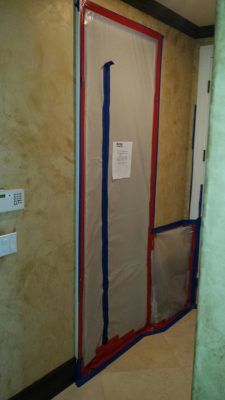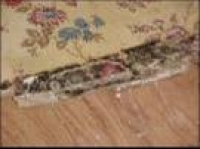MOLD REMEDIATION GUIDE: MOLD IS A REAL THREAT
As a mold remediation professional, you know mold is more prevalent than the average person might realize. Although exposure to certain types of mold is harmless in small doses, large mold colonies that develop in moist, low-airflow areas can cause serious harm to anyone who occupies a building with mold.
This fungal life form grows in multicellular structures called hyphae. Hyphae have a thread-like shape and can be used to differentiate mold from single-cell fungi, which are called yeasts. When mold spreads into groups of multiple hyphae, it is called a colony.
Mold emits small airborne elements called spores as a means of reproduction. Trace amounts of mold spores are nearly always in the air you breathe outdoors, but in an enclosed environment like a building, the presence of large mold colonies can create high concentrations of mold spores that will eventually make their way into the respiratory tract of nearby humans.
HEALTH EFFECTS OF TOXIC MOLD
Exposure to spores can have moderate to serious health effects on people. These effects are magnified for immune-compromised individuals and can include respiratory agitation, respiratory infection, allergic reactions, rash, cold-flu type symptoms and in extreme cases even death.
The spores that molds emit contain natural poisons called mycotoxins. These toxins disrupt human cellular structures and processes — for example, protein synthesis, DNA and RNA synthesis. In more severe cases, neural effects have been reported, which include degradation of eyesight and color differentiation, deterioration of the visual field and reduced cognitive function.
Of the more than 21 million Americans living with asthma, approximately 4.6 million — nearly a quarter of all those affected — are believed to suffer from the condition because of exposure to mold. While this study was focused on fungus exposure in homes, rather than commercial buildings, the estimated cost of medical expenses incurred due to these cases was $3.5 million.

Mold Removal Tips and Cleaning Guide
Mold Removal Tips
This project is meant to serve as a guide for anyone who has experienced water damage and mold inside their building. The methods seen here are just recommendations, and your specific mold removal specialist may choose to do things different. Use descretion when deciding what is best for you
Containment for mold removal
A containment should be established before removing moldly building materials over 10 sq. feet. The containment serves as a barrier and isolates the work zone from the remaining indoor environment.
Cover the flooring
Mold removal techniques involve the demolition of building materials – drywall and plaster. Cover the flooring to protect the finished flooring within your work zone.
Note: Not all flooring has to be covered. Some mold removal companies will wipe the surfaces of the floor with an approved anitmicrobial solution before laying plastic on the floor.
Mold Sealants
Some mold removal specialist will use foam or silicone sealants to fill gaps in between the building materials. Filling the gaps in these areas will help prevent air, from exterior sources, intruding into the enclosure.
Note: Try to use these materials sparingly. A little goes a long way
Mold Removal Machines
Mold removal experts use specialized machines that filter mold spores and particles out of the air. Mold Removal Machines are proficient at removing particles (such as mold spores) by passing the air through a HEPA filter. The efficiency of a HEPA filter is 99.9% of particles 2-200 microns.
Note: Directionality – what way do you point your negative air machine and how often do you change the filters? Mold removal machines need to be broken down, cleaned, and each filter changed prior to or after finishing your job.

A Guide For Toxic Black Mold Removal
When a mold inspector is performing mold testing, any amount of Stachybotrys or toxic black mold is considered an automatic failed test. The reason for this is that there should never be any amount of these toxic species of mold in an indoor environment. Its presence alone is almost always an indicator of current or past water intrusion and mold growth on drywall somewhere.
While this species of mold is different in the fact that its mold spores release mycotoxins into the air, the process for Toxic Black Mold Removal is no different than any other professional mold remediation. The key word here is “professional”. When black mold is present the removal should not be attempted by anyone, even a contractor unless the have training specific to mold remediation. If you are considering taking on this job yourself, please take a look at all of the following steps needed to complete the job correctly and safely first.
Create Temporary Containment
Wear Mold Respirator and Full Tyvek Body Suit
HEPA Vacuum
Remove Contaminated Building Materials
Apply Anti-Microbial Cleaning Chemicals
Run Air Scrubbers for 72 Hours
Thorough Cleaning of HVAC System
Clearance Test to Ensure Job Completed Properly
Risk vs. Reward
We understand that nobody likes to pay for expensive services and mold remediation definitely falls under that category. At the same time we hope that the above list gives you a better idea about what is involved in the process of black mold removal and you see why the price tag on the service is as high as it is. If you truly want to get rid of black mold, hiring a professional is the only option to avoid hazardous living conditions
Mold Inspection, Evaluation, Removal and Remediation
Mold is found everywhere: indoors (100,000 spores per gram in carpet dust), outdoors (75,000 spores per cubic meter in summer air), and especially on the Web. Black mold (Stachybotrys) gets all the press, but it is by no means the most dangerous of the frequently found molds.
Truly Useful Information on Mold Testing and Remediation (Removal)
Here, and in the pages listed in the left panel, is our version of “All You Really Need To Know About Inspection, Evaluation and Removal of Indoor Mold:”
A “mold-free” building is an unnatural state and an impossible goal. Every breeze, draft or visitor brings a variety of molds in. The objective should be a normal indoor environment, without conditions that are unusually hospitable to the growth of naturally occurring molds.
Today mold X, tomorrow Y. Or here X, there (somewhere) Y. One must not read too much into snapshots of an ecology, as would be shown by either bulk or air samples. The air is a soup of different mold spores, and whichever one happens to land on a favorable spot will colonize it. Others that land nearby may fight for the same territory; it’s always a contest as long as the conditions for growth are favorable.
The existence of any visible mold — no matter what kind — inside a home is an indication of something wrong, i.e. an existing or prior moisture problem that should be corrected along with any decontamination.
No variety of mold can be said to have zero adverse health effects in all people.
Stachybotrys (“Black Mold”) is not the most dangerous of the frequently found molds.
Stachy needs a constant source of moisture. It loves wet drywall, but is seldom found on wood.
Its claim to fame is the toxins in its body, and if you ate enough of them (some say one square inch) you could be dead in a hurry.
However, nobody — NOBODY — has ever died from breathing Stachy spores.
It is incapable of growing in the human body, but is equally toxic whether dead or alive.
Infectious organisms (such as some varieties of Aspergillus) may have sheaths that are less toxic, but they are capable of colonizing the lungs and then migrating to (for example) the brain. People have died from these molds.
Mold
Mold Basics
Molds can be found most anywhere – indoors and out. There are thousands of types of mold in Tennessee and all over the world, many of which produce spores. Spores spread easily through the air and can form new mold growth on surfaces when conditions are right. Above all else, molds need moisture to live and grow. If there is mold growing in your home, there must be a source of moisture or a water problem.
What are the health effects of mold?
Mold is usually not a problem indoors unless it finds a damp environment and starts to multiply. Molds can produce allergens, irritants, and in some cases, mycotoxins. Many people have no reaction to mold. Allergic reactions and irritation are the most common health effects for people sensitive to mold. Mold exposure can also trigger asthma attacks in people with asthma
According to the Centers for Disease Control and Prevention (CDC), a link between mold and other health effects such as memory loss, lethargy and acute idiopathic pulmonary hemorrhage among infants has not been proven. The term “Toxic Mold” is often used by the media, but it is not accurate. While some molds do produce toxins, the molds themselves are not toxic or poisonous. Hazards presented by molds that produce mycotoxins are the same as other common molds that may grow in your home.
Should I test my home for mold?
In general, it is not necessary to test for mold. Both the CDC and the Environmental Protection Agency (EPA) do NOT recommend testing. No matter what type of mold is present, you should clean it up and make efforts to prevent further mold growth. Since the effect of mold on people can vary greatly, the presence of mold in the home does not imply a health risk.
Tips for mold prevention:
Fix leaky pipes, roofs and windows
Maintain low indoor humidity, ideally 30-50%.
Perform regular HVAC inspections and maintenance
Do not carpet bathrooms and basements
Ventilate shower, laundry and cooking areas
Promptly clean up and dry out your home after flooding